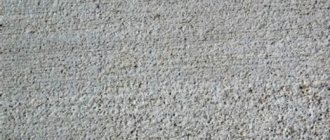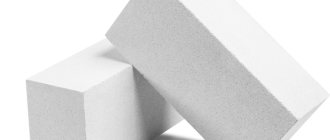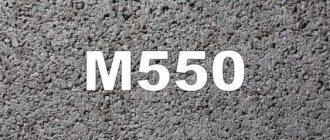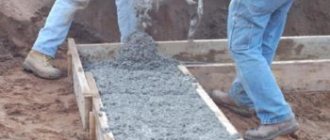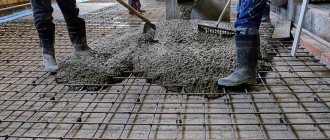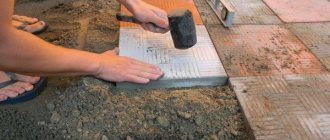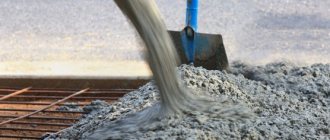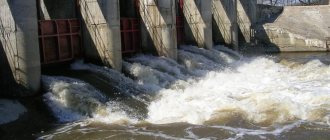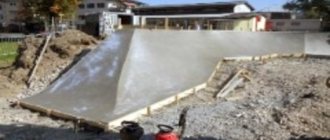Concrete mix composition
Concrete grade M150 consists of four main ingredients: cement, crushed stone or similar gravel, fine sand and clean water. High-quality cement plays a major role in the stability of the future structure. For concrete mortar grade 150, preference is given to the M400 cement mixture. The material can withstand loads of up to 400 kilograms per 1 cm2 of structure. Crushed stone (gravel) will help prevent the appearance of small cracks and crumbling of the structure. The particle size in it should not exceed 15-20 mm. Sand extracted from a river bottom or a quarry most accurately meets the required parameters of the concrete mixture. If there are large contents, the component should be ground to a size of no more than 5 millimeters. The final ingredient of concrete is water. Only clean liquid should be added, without impurities or dirt.
What is concrete M150 used for?
Low price and ease of manufacture make M150 concrete mortar an extremely popular material. It is used to solve a wide range of problems in construction:
- creation of a reinforced foundation cushion on equipped waterproofing;
- pouring foundations for light one-story buildings and temporary structures;
- floor screed in domestic premises, industrial, commercial or public facilities with low load on the floor;
- arrangement of personal, garden or park paths, and courtyards, pedestrian areas;
- laying road base under asphalt;
- production of slabs and blocks for load-bearing structures under light loads;
- erection of fences, installation of pillars; construction of partition walls.
When erecting structures made of M150 concrete, care must be taken to install drainage and waterproofing systems. When constructing a screed, the top layer is reinforced using cement or special additives.
This material is inexpensive compared to other solutions, which reduces the cost of construction work. It is quite resistant to temperature changes and high humidity, provided it is properly waterproofed. This is an environmentally friendly material that can be used without restrictions in the construction of residential premises and other buildings and structures.
Specifications
Construction mixtures have a number of properties, based on which builders determine their scope of application.
The porous structure of concrete allows moisture to pass through, so additional protection against waterproofing is required during use.
M150, as a class of concrete, has a number of characteristics that distinguish it from other brands:
- Possibility of plasticity variation. Ease of use can be changed depending on the amount of water added. Thus, a more liquid solution implies the possibility of adjustment when laying bricks or blocks. A thick mixture hardens faster and makes it impossible to move or remove the object.
- Strength class. Located between B10 and B12.
- Relatively low frost resistance. Concrete mixture grade M150 has a grade of F50. The builders explain that the structure made from it will withstand up to 50 cycles of temperature changes.
- Waterproof level - W2. Application in places with high humidity requires an additional moisture-proof layer. Unlike grade B25, concrete B10 has a more porous structure.
- Density of concrete. Adjustable and dependent on sand or crushed stone content. The recommended application density is 2200 kilograms per 1 cubic meter of construction.
What is the composition of the material?
The set of components for creating a solution is standard:
- sand;
- cement;
- aggregate;
- water;
- additives.
You just need to choose the right proportions.
For mixing M150, Portland cement is used. It should be about 11% of the total mass. When adding it, you need to check the production date and timing. If they fail, the component will not provide the required properties.
The sand for the solution is medium or fine. It must be pre-rinsed and cleaned. It should not contain unnecessary impurities. It is recommended to take coarse aggregate, with a fraction of 5-20 mm. It is also cleaned and moistened with water before being added to the bulk. The filler directly affects the quality of the resulting material.
The water must be clean. There should be no debris or foreign impurities in it.
Using additives, you can give the material improved resistance to frost and humidity.
For example, here is the composition of 1 cube of solution:
- 250 kg of cement;
- 800 kg of sand;
- 1150 kg of crushed stone;
- 160 l of water;
- 2.5-4.5 kg of additives - the amount may vary in different instructions and mixtures.
The mass of one cubic meter of concrete will be about 2.4 tons.
The price of M150 concrete is approximately 3.2-3.8 thousand / cubic meter. meter. If you need to buy M150 concrete with delivery, then add approximately 20% of the total amount to the total cost. But even with such costs, this concrete is completely inexpensive.
DIY cooking
The main components of the solution are sand, crushed stone and cement, which after mixing are filled with water.
For small volumes of work, you can prepare a concrete mixture at home. The process is not difficult, especially when using a concrete mixer. First of all, prepare the necessary ingredients. Experienced builders advise not to purchase expensive cement, since the price does not affect the characteristics of the resulting solution. Sand and cement mixture are gradually poured into a dry concrete mixer. After several revolutions of the tool, crushed stone or gravel is added. The last component - water - is added after thorough mixing. If there is no concrete mixer, a number of actions are performed:
- Lay a dry oilcloth on the floor or place a clean basin.
- Add the required amount of sand mixture.
- Add cement and mix lightly.
- Add crushed stone and mix the ingredients until smooth.
- Pour water in small portions, constantly stirring the solution.
Do-it-yourself concrete production
Under factory conditions, all concrete mixtures are produced in forced mixers of various types, ensuring uniform mixing of all components. The final properties of the material depend on the quality of mixing, which is why experienced operators monitor the mixing process at RBU.
You can make artificial stone of the M150 brand on your own. A small-volume gravity mixer, which can be purchased at any construction or garden market, is quite suitable for this.
Loading Components
The mixer bowl must be moistened to reduce binder dust. Next, all raw materials are loaded in the selected proportion, and mixing water with an additive is added. To reduce dust, it is best to mix sand, crushed stone and water first, adding cement last.
To increase the service life of the mixer, the loading order is changed. First, cement, sand and water with an additive are introduced, and only after the mortar part is prepared, coarse aggregate is added.
Mixing
Mixing time may vary, the main criterion is to achieve homogeneity of the mixture. For a gravity mixer, the optimal mixing time for components is 3 – 5 minutes. The lower the mobility of the mixture, the longer it takes to mix it and achieve homogeneity.
Compliance with the calculated recipe and careful attention to the production of the concrete mixture guarantee the receipt of high-quality and reliable material.
Advantages and disadvantages
Concrete mixture grade M150 is characterized by a number of advantages. Builders note the low cost and ease of preparation, the absence of harmful impurities and plasticizers. A correctly calculated ratio of components will ensure a long service life of the resulting buildings. At the same time, builders also note disadvantages. These include the inability to use for working with large objects and a low level of moisture resistance. It is recommended to consult with a professional before starting construction.
Advantages and disadvantages of Concrete m150
The strength indicators of the M150 concrete are not very high, but it has some advantages:
- low cost of repair or construction work;
- environmental safety of the material, since only natural ingredients are used for its preparation: crushed stone, sand, cement, water;
- B10 concrete does not lose its properties with minor temperature fluctuations and increases in humidity levels;
- long service life.
The fire protection of B10 concrete is 2 hours 30 minutes. But this brand of solution has significant disadvantages. Under constant influence of negative temperatures, the B10 concrete layer loses its strength and may collapse. It is not recommended for use in capital construction as a base material.
Composition and proportions
Concrete M150 (GOST 7473-94) has a certain composition. For example, cement is added in a volume of 11% of the total mass. Portland cement I-II 32.5 is used for mixing. But it makes no sense to use high grades of it, since consumption will be reduced. As for sand, the most commonly used material is with a fraction ranging from 1.5 to 2 mm. The filler is well cleaned and washed.
Limestone or gravel is used as coarse aggregate. Crushed stone particles usually have sizes ranging from 5 to 20 mm. If you clean this component from dirt, the quality of the concrete solution will be increased. Water must also be free of biological and chemical additives. In order to make concrete moisture-proof and frost-resistant, special additives are used, as well as to improve strength.
Properties of concrete 10
Heavy concrete of this category has not only low strength, but also insignificant indicators of resistance to moisture and low temperatures. These properties predetermine its importance in construction production and areas of use. Along with other grades, concrete B 10 must meet GOST 26633-2012 “Heavy and fine-grained concrete. Technical specifications" and other regulatory documents. Failure to comply with these requirements will certainly lead to devastating consequences.
The technical characteristics that are inherent in M150 B10 concrete are outlined below:
| Index | Unit change | Standard |
| Compressive Strength | MPa | 13 |
| Same | kgf/cm2 | 150 |
| Tensile strength | MPa | 1 |
| Density | kg/m3 | 2100 |
| Waterproof | brand | W2 |
| Frost resistance | F50 | |
| Workability | P2-P3 |
The volumetric weight of B10 concrete is in the range of 1800-2100 kg/m3, depending on the quality of the crushed stone used, in addition to which, as usual, cement and sand are used to prepare this material. Plasticizing, antifreeze, and hardening-accelerating additives are also not excluded.
The following requirements apply to raw materials:
- There is no reason to use high-grade cement, since too little binder consumption will make it impossible to prepare a homogeneous mixture. Therefore, cement grades M200-M400 are best suited.
- Sand should be taken clean and of medium coarseness.
- Almost any crushed stone or a mixture of different rocks can be used. But most often gravel or lime material is used; gravel on its own or as part of a sand-gravel mixture is also suitable. The preferred fraction is 5-20 mm, crushability grade is from M300 to M600.
If you use granite crushed stone, then it will not make significant changes to the properties of M150 B10 concrete, but will significantly increase the cost.
Manufacturing Features
Concrete M150, the characteristics of which were mentioned above, is manufactured using a special technology. The most effective way to do this is to use a concrete mixer. The inner surface of the container is wetted to prevent the formation of large amounts of dust during kneading. It is important to maintain the correct ratio of ingredients, load crushed stone, sand and water. Once everything is well mixed, you need to add the required amount of water to the composition.
